Need to spec out a plan for a client? Wondering what the core elements of a good social marketing strategy ought to include?
In this article, you'll find a good strategy, workflows, and more.

#1: Clarify Your Social Media Strategy to Develop a Clear Path Forward
Marketers know that having a documented strategy is strongly correlated with success. But we also know that social media marketing moves fast, often leaving documented strategies obsolete shortly after they're written.
The best approach, then, is to keep your strategy simple, flexible, and adaptable. That way, you can provide your team with a framework to follow without spending an excessive amount of time crafting a plan that will be rendered useless tomorrow.
Here's what a basic strategy should include:
- Goals. What will you achieve?
- Customer persona. Who are you targeting?
- Brand voice summary. How should your content sound?
- Selected networks. Where will you be present?
- Posting frequency. How often will you post?
You can easily document your strategy by creating a Word document or PowerPoint presentation with sections dedicated to each of these points.
To save some time, you can use this publicly available Google Sheets template. It's easily editable and includes a slide for each of the following sections.

Set Goals
This post is all about getting organized to improve your odds of success. Before you can define success, however, you need to set clear goals. They're what you'll measure your results against.
The first step is to determine your business objectives, and then set social media goals that align with those objectives. This will ensure that your strategy impacts actual business outcomes.
Marketers commonly ask how they can set ambitious yet achievable goals. This question is difficult to answer without knowing how your business is currently performing, how long it's been active on a given network, and other factors.
If you're struggling to nail down numbers, consider starting with the average of your performance over the last 90 days on any given metrics, and aim for a 10% improvement over the next quarter. Should you blow past that goal, increase the percentage for the following quarter after that. Fall short, however, and you may need to reconsider your strategy or tactics.
There's nothing scientific to this approach. The idea is to simply find a starting point, and then go from there based on data and performance.
What matters most is that you're paying attention to the social media metrics that most closely align with what your business needs to achieve.
Get World-Class Marketing Training — All Year Long!
Are you facing doubt, uncertainty, or overwhelm? The Social Media Marketing Society can help.
Each month, you’ll receive training from trusted marketing experts, covering everything from AI to organic social marketing. When you join, you’ll also get immediate access to:
- A library of 100+ marketing trainings
- A community of like-minded marketers
- Monthly online community meetups
- Relevant news and trends updates
Develop a Customer Persona
If your marketing team has already created a persona for your target customer, then this step will be easy.
However, if you're developing one from scratch, there are ways to simplify the process. Creating personas can be complex but you can take a lean approach to get started.
Begin by determining who your target customer might be. Your marketing team may have this information or it might be within another business unit in your organization.
Next, use in-app analytics on your company's Facebook page to find some basic information about your fans.
Log into your company's Facebook page, then visit the Insights tab, and click People within the left-hand navigation. Here, you can find some basic information about your fans:
- Age
- Gender
- Geographic location
- Language

This isn't much data, but it's a start. To get more detailed information, use Google Analytics. Click into your account, and then click through Audience > Interests:
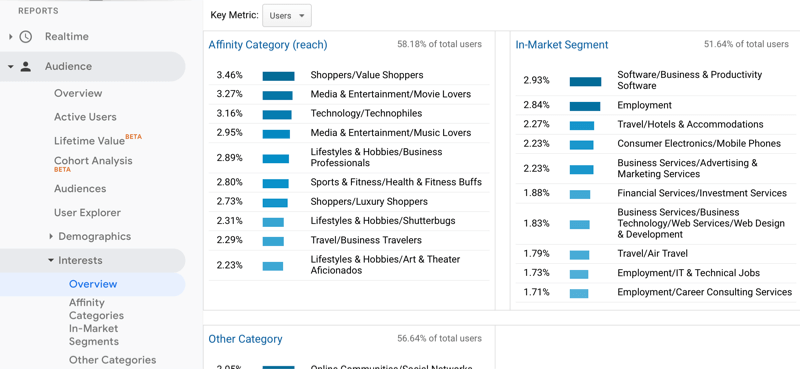
This tells you about the interests of people visiting your website. To make this more useful specifically for social media marketing, click through Acquisition > Social > Network Referrals:
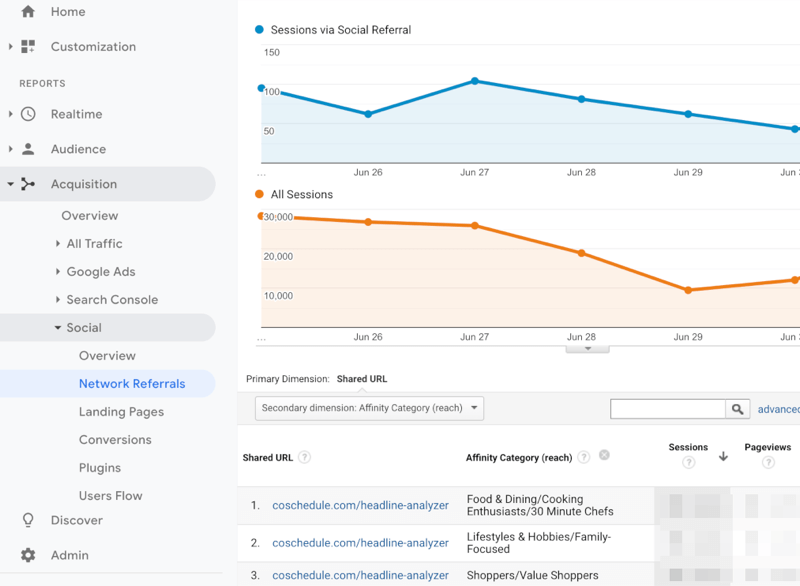
Next, under the Secondary Dimension drop-down, scroll down to Users and select Affinity Category:
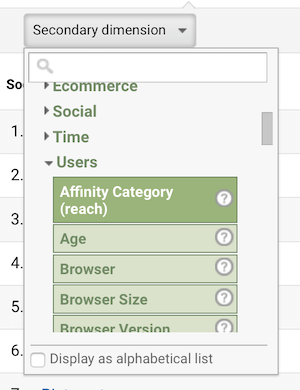
You now have access to some high-level data about your social media audience's interests based on who's being referred to your website from your social media channels.
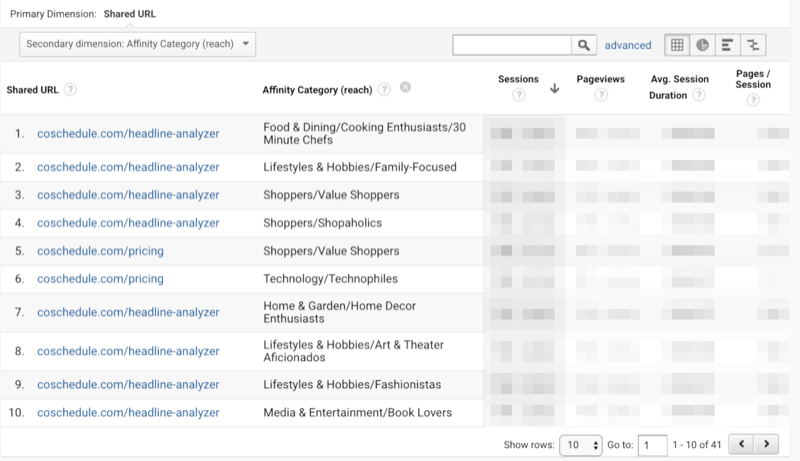
Next, ask the following questions:
- Who do we believe is our target customer?
- Does our social media following align with this demographic?
- How can we construct a basic description of our ideal customer?
The answers to these questions will help you understand whether social media is attracting the best prospects to your business. It can also help you understand the interests of the visitors who convert most on your website.
Establish a Brand Voice for Social Media
What do many of the most successful brands on social media have in common?
A distinctive voice.
Mattress company Casper keeps a dry sense of humor (while keeping their content connected to their product):
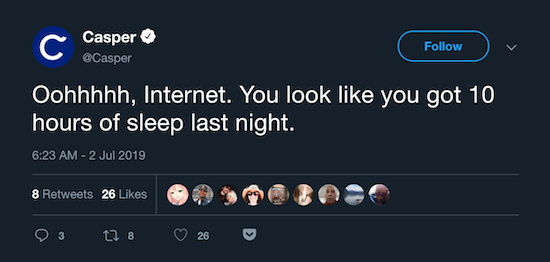
Smoothie brand Innocent is also well-known for sharp wit:

Brands don't necessarily need to be funny to stand out, although humor does seem to draw a lot of attention. Take a look at this post from stone countertop manufacturer Cambria, which maintains an understated and authoritative voice:

How do these brands do it? They understand their brand voice. Developing one for your company is a key part of staying organized versus having your posts sound scattershot.
Here's an easy way to establish brand voice:
- Ask who you are.
- Ask who you are not.
List several questions and answers to yourself following this format: “We are [INSERT ATTRIBUTE], but we are not [INSERT ATTRIBUTE].”
This exercise can help you quickly ascertain how your brand might sound on social media. Instead of sounding exactly like everyone else (or sounding like no one in particular), you can establish a voice and tone that will give your social media presence a uniform feel, and help you attract the right people.
Your finished brand voice summary might sound something like this:
We are light-hearted, but we are not goofy.
We are humorous, but we are not snarky.
We are inspirational, but we are not cheesy.
Try it and see what you can come up with that might resonate with your audience.
Audit and Prioritize Your Networks
The next step in getting organized is understanding which networks you need to be on.
This includes determining:
- Which networks are performing well right now: Your analytics will let you know what's doing well and what isn't.
- Which networks are underperforming: Consider whether they're worth keeping or if your execution simply needs improvement.
- Which networks you should consider joining: Are there networks you're not on but that could be effective for your business?
It's best to manage each network within a social media scheduling and management platform. There are tons of these available on the market. Consider options that include collaboration, workflow, and task management capabilities to maximize your organizational power.
Establish a Posting Frequency
There's no set posting frequency that can guarantee success. However, maintaining a consistent posting schedule is vital for staying organized and maintaining a continuous presence.
Here are some simple starting points to consider for each network:

Discover Proven Marketing Strategies and Tips
Want to go even deeper with your marketing? Check out the Social Media Marketing Podcast! Publishing weekly since 2012, the Social Media Marketing Podcast helps you navigate the constantly changing marketing jungle, with expert interviews from marketing pros.
But don’t let the name fool you. This show is about a lot more than just social media marketing. With over 600 episodes and millions of downloads each year, this show has been a trusted source for marketers for well over a decade.
- Facebook: 1 post per day
- Twitter: 15 tweets per day
- Pinterest: 11 pins per day
- LinkedIn: 1 post per day
- Instagram: 1 post per day
Adjust your approach according to results, which networks you're active on, and available resources to create social content.
#2: Organize Project Planning to Eliminate Ambiguity
Proper planning precedes success. Marketers who carefully plan their campaigns and projects report being 356% more likely to succeed.
Any team can put a simple process in place for doing this.
Start Every Campaign With a Creative Brief
It's easier to keep projects organized when everyone is (literally) on the same page.
A creative brief (or project brief, depending on your preferred terminology) is a one-page document that lists the requirements for a project or campaign. It should include the following pieces of information:
- Project summary: Describe the project or campaign at a high level.
- Details: This should answer who the project is aimed at, its goal, and the technical requirements for deliverables (e.g., image sizes, video resolution, etc.).
- Process: List the steps that need to be completed in order.
- Team members: Who will work on this project?
- Timeline: When is the project due?
- Resources: What will you need to get this done?
That's it. A shared Google Doc or Word document with this information should suffice. You can also use the template pictured below, which you can find here.
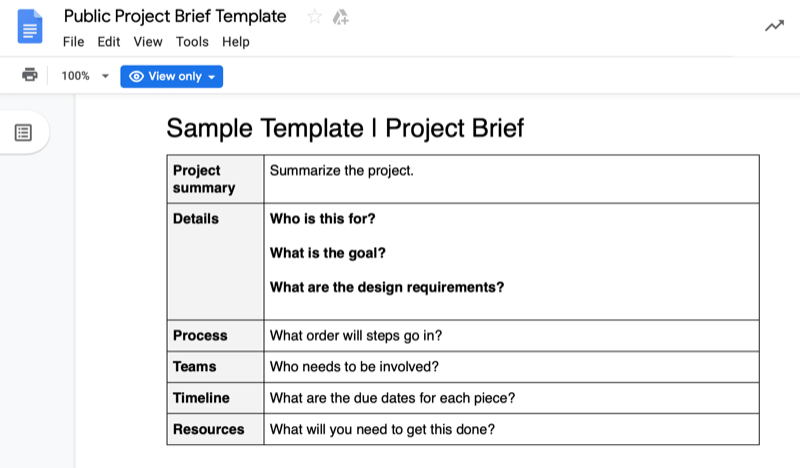
Kick Off Large-Scale Projects With a Team Huddle Meeting
Once you have written a project brief, schedule a meeting to share it with the team. If you've never run a meeting, this may be somewhat intimidating. However, here's all you need to get it right:
- Block off time and space to meet and add it to your inter-office calendar.
- Familiarize yourself with the brief so you don't have to ad-lib during the meeting.
- Leave time for questions because the team will almost certainly have some.
Plan to spend about half an hour on the meeting. By the time you're done, you should have the following:
- Who needs to be responsible for what tasks?
- What order should those tasks be in?
- How long will each task take to complete?
This information will be essential to complete the next step in this process.
Set Up Social Media Workflows With Checklists
Checklists are powerful organizational tools when wielded the right way.
By documenting your workflows as checklists, you can make sure every task and campaign gets completed the right way every time. They ensure nothing gets missed and help develop positive habits.
Follow these steps to plan out an effective workflow:
- List all the steps required to complete a certain type of project (campaign planning, video shoot, etc.).
- Estimate how long each step generally takes (and if you don't know the answer, ask the person who typically completes that task).
- Assign each task to a team member along with a deadline for each task.
Here's a sample set of steps for creating a social media campaign.
[ ] Develop campaign concept.
[ ] Write social media posts.
[ ] Draft direction for social media design.
[ ] Design social media graphics.
[ ] Review copy and design.
[ ] Import copy and graphics into social media scheduling tool.
[ ] Set publishing date and time.
Now, here's the same workflow with a team member assigned to each step:
[ ] Develop campaign concept. (Strategist)
[ ] Write social media posts. (Copywriter)
[ ] Draft direction for social media design. (Copywriter)
[ ] Design social media graphics. (Graphic Designer)
[ ] Review copy and design. (Manager)
[ ] Import copy and graphics into social media scheduling tool. (Strategist)
[ ] Set publishing date and time. (Strategist)
Finally, here it is with deadlines assigned:
[ ] Develop campaign concept. (Strategist – 4 Hours)
[ ] Write social media posts. (Copywriter – 6 Hours)
[ ] Draft direction for social media design. (Copywriter – 2 Hours)
[ ] Design social media graphics. (Graphic Designer – 8 Hours)
[ ] Review copy and design. (Manager – 1 Hour)
[ ] Import copy and graphics into social media scheduling tool. (Strategist – 0.5 Hours)
[ ] Set publishing date and time. (Strategist – 0.25 Hours)
Follow this process to develop workflows that make sense for you. Start with tasks, then add assignees and estimated completion times.
#3: Coordinate Posts and Campaigns With a Social Media Calendar
How often have you been asked to create a post (or even a campaign) on the spot? And how have you felt about the work you've completed without planning? The answer to those questions is probably “too often” and “not great.”
What's the solution? Use a social media calendar to strategically plan posts and make sure you always have enough content to keep your audience engaged.
The most cost-effective way to build a calendar is with a spreadsheet; you can find a publicly available template at no cost here (please download the file or click File > Make a Copy to create a copy for yourself). This is what it looks like:
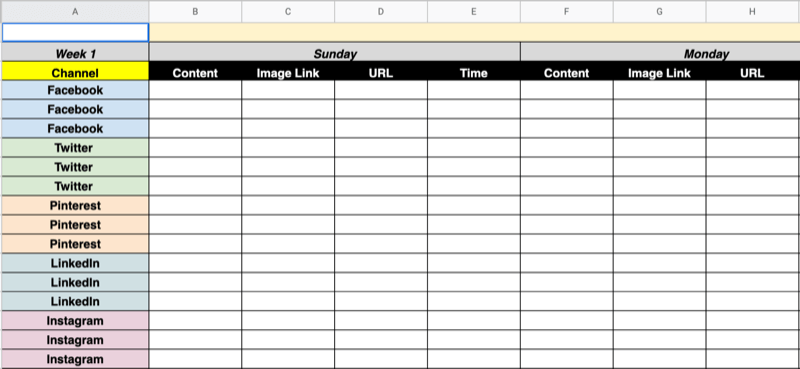
It's simple and straightforward to use. For each post, include the following:
- Post copy: Your caption or post text.
- Image link: Store your image in cloud storage (Google Drive, Dropbox, etc.) or a digital asset manager, and link to where each image can be found.
- Time: When should the post be published?
- URL: If the post will include an external link.
Next, devise a simple color-coding system to organize your calendar. Here are some ideas for how your calendar could be organized by color:
- Campaigns: All posts tied to one campaign should be color-coded together.
- Content types: Videos, posts sharing blog posts, and others
- Team members: Who's responsible for creating each post?
You can edit or color-code this calendar to fit as many posts as you need, and organize it any way you'd like.
Pro Tip: Use a content-approval process to review work efficiently and make sure errors don't get published.
#4: Establish a Reporting Schedule to Prove Your Value
Part of the reason we're taking time to get organized is to improve business and marketing outcomes. To show how you're doing this, you'll need to report on social media marketing performance. This should be something that's done on a regular basis so you aren't caught without an answer when asked how you're contributing value to the company.
Most social media management platforms include analytics and reporting functionality. Use yours to export and email reports on a weekly or monthly basis. Consider looping in anyone who might benefit from having that information (or anyone who may be interested).
Conclusion
Getting organized takes some time up front; however, once effective tools and processes are put in place, they can yield immense benefits for your productivity, team happiness, and overall success.
Now that you have all of the information you need, it's time to put it into practice. Use the tips above to organize your next marketing campaigns.
What do you think? Will you use this checklist in your own work? Do you have other tips to offer? Share your thoughts in the comments below.
More articles on social media marketing:
- Find out how to get more social media engagement on any platform.
- Learn how to build a community in a changing social media world.
- Discover 10 metrics worth tracking for your next marketing report.
Attention Agency Owners, Brand Marketers, and Consultants

Introducing the Marketing Agency Show–our newest podcast designed to explore the struggles of agency marketers.
Join show host and agency owner, Brooke Sellas, as she interviews agency marketers and digs deep into their biggest challenges. Explore topics like navigating rough economic times, leveraging AI, service diversification, client acquisition, and much more.
Just pull up your favorite podcast app, search for Marketing Agency Show and start listening. Or click the button below for more information.

